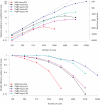Simulating human cardiac electrophysiology on clinical time-scales
- PMID: 21516246
- PMCID: PMC3079856
- DOI: 10.3389/fphys.2011.00014
Simulating human cardiac electrophysiology on clinical time-scales
Abstract
In this study, the feasibility of conducting in silico experiments in near-realtime with anatomically realistic, biophysically detailed models of human cardiac electrophysiology is demonstrated using a current national high-performance computing facility. The required performance is achieved by integrating and optimizing load balancing and parallel I/O, which lead to strongly scalable simulations up to 16,384 compute cores. This degree of parallelization enables computer simulations of human cardiac electrophysiology at 240 times slower than real time and activation times can be simulated in approximately 1 min. This unprecedented speed suffices requirements for introducing in silico experimentation into a clinical workflow.
Keywords: monodomain model; personalized health care; strong scalability.
Figures



References
-
- Balay S., Buschelman K., Eijkhout V., Gropp W. D., Kaushik D., Knepley M. G., McInnes L. C., Smith B. F., Zhang H. (2008). PETSc Users Manual. Technical report ANL-95/11 – Revision 3.0.0. Argonne National Laboratory, Argonne, IL
-
- Bishop M. J., Plank G., Burton R. A. B., Schneider J. E., Gavaghan D. J., Grau V., Kohl P. (2010). Development of an anatomically detailed MRI-derived rabbit ventricular model and assessment of its impact on simulations of electrophysiological function. Am. J. Physiol. Heart Circ. Physiol. 298, H699–H718 - PMC - PubMed
-
- Dang L., Virag N., Ihara Z., Jacquemet V., Vesin J.-M., Schlaepfer J., Ruchat P., Kappenberger L. (2005). Evaluation of ablation patterns using a biophysical model of a trial fibrillation. Ann. Biomed. Eng. 33, 465–474 - PubMed
Grants and funding
LinkOut - more resources
Full Text Sources
Other Literature Sources

